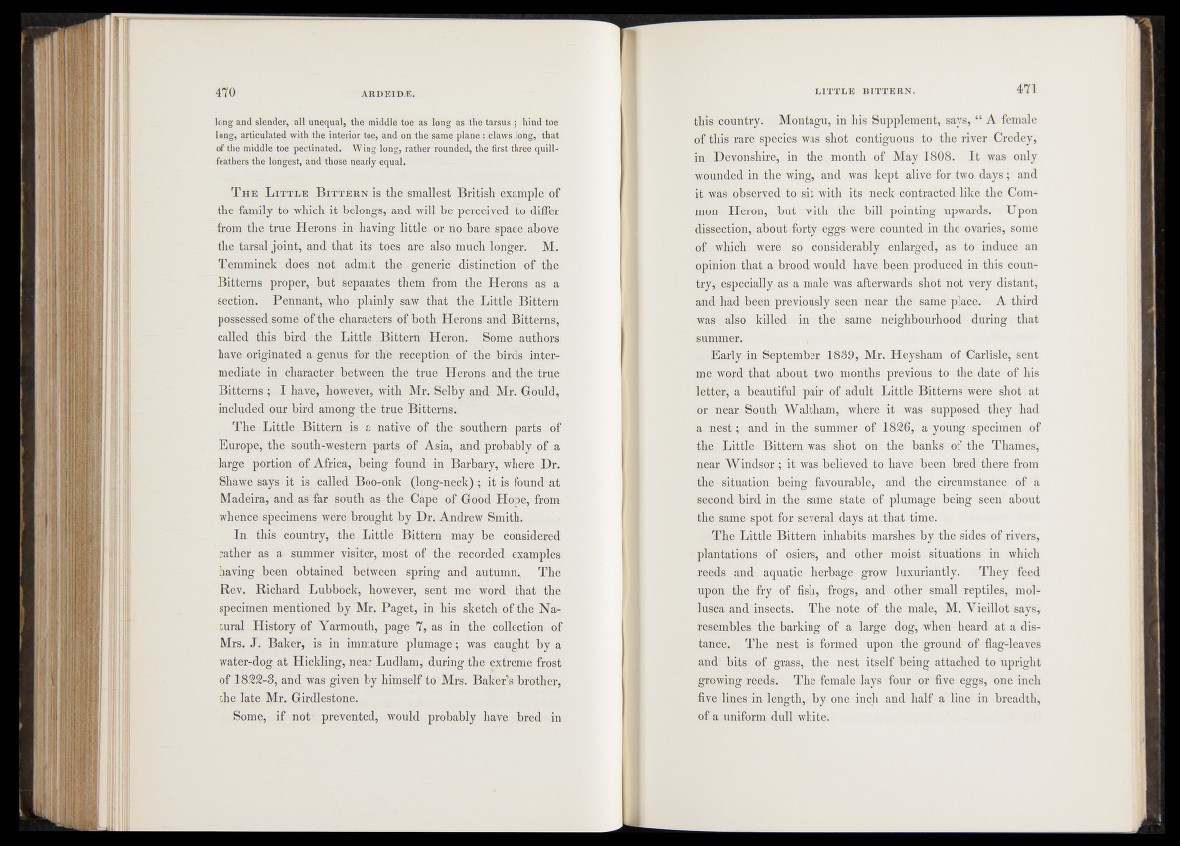
long and slender, all unequal, the middle toe as long as the tarsus ; hind toe
long, articulated with the interior fee, and on the same plane: claws long, that
of the middle toe pectinated. Wing long, rather rounded, thé first three quill-
feathers the longest, and those nearly-equal.
T h e L it t l e B it t e r n is the smallest British example of
the family to which it belongs, and will be' perceived to differ
ïrom 'thé true Herons in having littl^ o r no- bare space above
the tarsal Joint, and that-its- toes are also much longer. M.
Temminck does not admit the generic distinction of the
Bitterns proper, but separates them from the Herons as a
section. Pennant, .who plainly saw that the Little Bittern
possessed sqmë of the characters , of both Herons and Bitterns,
called this bird the Little. Bittern Heron«. Some, authors
have originated a-genus for thb reception of the birds Intermediate
in character between thf^irue Herons and the true
Bitterns ; I have, however,-with Mr, Selby and-Mr. Gould,
included our bird among thè' true Bitterns/
The Little Bittern is a hatlve.cf—the^ioutherii .parts of
Europe, the south-western parts of Asia, and probably of a
large portion of Africa, being found in Barbary, where Dr.
Shawe says it is called Boo-onk ^Hong-mick) ; it-is found at
Madeira, and as far south as the Cape ,of Good Hope, from
whence specimens were brought-by Dr. Andrew Smith. .
In this country, the < Little Bittern may |re€ considered
rather as a summer visiter, most of the recorded examples
having peen obtained between spring and autumn.,. The
Rev, Richard Lubbock, however, -sent me word that the
: specimen mentioned hy Mr. Paget, in his sketch.pf, the Natural
History of Yarmouth, page 7, as in the collection of
Mrs. J. Bakerj is in immature plumage ; was caught by a
water-dog at Hickling, near Ludlam, during the extreme frost
of 1822-3, and was given by himself to Mrs. Baker’s brother,
the late Mr. G milestone.
Some, if not' prevented, would probably haifc? bred in
this-country^ r Montagu, in , his Supplement, says, “ A female
of this rare species was shot contiguous to the river Credey,
in Devonshire, in,: the month of May 1808. I t was only
yraunded in the-wing, and was kept alive for two days; and
it •7va^d§M^vedif,t0^sit with its neck« contracted like the Common
HSronv butt with the bill pointing upwards. Upon
disseatiO^^abontTorty' eggs were counted in the ovaries, some
of- which, were so j considerably enlarged, as to induce an
opi|ii.|Bi> that a-brood would have been produced^in this coun-
try^iOgpeeially- as a, male was afterwards" shot not very distant,
and- hadukeen previously: seen near, .the' same plaee. A third
was also ki-Hedv-in thei.sam^sneighbourhood during, that
summer.
, Early in September 1839, Mr. Ileysham of Carlisle, sent
me word that about two months previous to the date of .his
letter, a beautiful pair of adult Little Bitterns were shot i at
qt '.near'Sorath Waltham, whe^fe;. it was supposed they had
a n e s t a n d in the summer of 1826,, a young specimen of
the Little Bittern was shot on the banks of the Thames,
near Windsor ; ”it Vas believed to havet be®, bred there from
the situation being favourable^ and the circumstance of a
second bird in the same statejof plumage being seen about
th^Sam|&p,bf..fo!r.;several days at that timei#^
The Little Bittern inhabits marshes by the sides of rivers,
plantations of osiers, and other moist situations in which
reeds and aquatic herbage grpw luxuriantly. They feed
upon the fry »*0'f fish,; frogs, and other small reptiles, molluscs
and insects. ,The* note of the male, M. Yieillot says,
resembles the barking of a large dbg^ when heard at a distance.
The .nest, is formed upon the ground of flag-leaves
and bits-of^ grass, the nest itself being attached to upright
growing-reeds, The female lays four orl five, eggs, one inch
five,;lin<3S in length, by one incji and half a line in breadth,
ofi a’.uniform dull white,